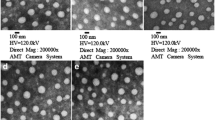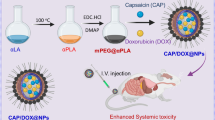ABSTRACT
Purpose
Emodin (EMO) has multi-targets and multi-way antitumor effect, which was limited by the instability and poor solubility of EMO. The aim of this study was to formulate EMO-loaded poly (lactide-co-glycolide)-d-α-tocopheryl polyethylene glycol 1000 succinate (PLGA-TPGS) nanoparticles (EPTN) to increase the liver targeting of EMO for cancer therapy.
Methods
EMO/coumarin-6-loaded PLGA-TPGS nanoparticles (ECPTN) and EMO-loaded PLGA nanoparticles (EPN) were also prepared as comparison. The cellular uptake of ECPTN by HepG2 and HCa-F cells was investigated using Confocal laser scanning microscopy. The apoptosis of HepG2 cells handled with EPTN was assayed by flow cytometry. The liver targeting property of ECPTN in mice was evaluated using the drug concentration determined by RP-HPLC and the freezing slices were investigated via fluorescence inversion microscopy. The blood samples were obtained from vein intubation to illustrate the pharmacokinetics process of EPTN. The tumor-bearing mice model was established to elucidate the in vivo therapeutic effect of EPTN.
Results
The results demonstrated that ECPTN could be internalized by HepG2 and HCa-F cells respectively. The ratio of apoptosis cells was increased after dealing with EPTN. The detection indexes of drug concentration and fluorescence inversion microscopy images indicated ECPTN had an excellent effect on liver targeting property than EMO solutions (EMS). The pharmacokinetics process of EPTN showed obvious sustained-release effect than EMS. Compared with EPN, the in vivo antitumor activity of EPTN against tumor cells were better.
Conclusions
In conclusion, EPTN could be used in the treatment of liver cancer acted as a kind of promising intravenous dosage forms.












Similar content being viewed by others
Abbreviations
- AUC:
-
Area under concentration-time curve
- C6:
-
Coumarin-6
- DL:
-
Drug-loading
- ECPTN:
-
EMO/coumarin-6-loaded PLGA-TPGS nanoparticles
- EE:
-
Encapsulation efficiency
- EMO:
-
Emodin
- Empty PTN:
-
Empty PLGA-TPGS nanoparticles
- EMS:
-
EMO solutions
- EPN:
-
EMO-loaded PLGA nanoparticles
- EPTN:
-
EMO-loaded PLGA-TPGS nanoparticles
- FS:
-
5-Fluorouracil solutions
- PDI:
-
Polydispersity index
- PLGA:
-
Polylactic-co-glycolic acid
- PLGA-TPGS:
-
Poly (lactic-co-glycolic acid)-d-α-tocopheryl polyethylene glycol 1000 succinate
- Re:
-
Relative targeting efficiency
- SI:
-
Selectivity index
- Te:
-
Targeting efficiency
- TI:
-
Targeting index
- TPGS:
-
D-α-tocopheryl polyethylene glycol 1000 succinate
- ZP:
-
Zeta potential
REFERENCES
Altekruse SF, McGlynn KA, Reichman ME. Hepatocellular carcinoma incidence, mortality, and survival trends in the United States from 1975 to 2005. J Clin Oncol. 2009;27(9):1485–91.
Jemal A, Center MM, Ward E, Thun MJ. Cancer occurrence. Methods Mol Bol. 2009;471:3–29.
Xu W, Yang G, Xu Y, Zhang Q, Fu Q, Yu J, et al. The possibility of traditional Chinese medicine as maintenance therapy for advanced nonsmall cell lung cancer. Evid Based Complement Alternat Med. 2014;2014:278917.
Olaku O, White JD. Herbal therapy use by cancer patients: a literature review on case reports. Eur J Cancer. 2011;47(4):508–14.
Wang W, Sun YP, Huang XZ, He M, Chen YY, Shi GY, et al. Emodin enhances sensitivity of gallbladder cancer cells to platinum drugs via glutathion depletion and MRP1 downregulation. Biochem Pharmacol. 2010;79(8):1134–40.
Chun GW, Jun QY, Bei ZL, Dan TJ, Chong W, Liang Z, et al. Anti-tumor activity of emodin against human chronic myelocytic leukemia K562 cell lines in vitro and in vivo. Eur J Pharmacol. 2010;627(1–3):33–41.
Chen HC, Hsieh WT, Chang WC, Chung JG. Aloe-emodin induced in vitro G2/M arrest of cell cycle in human promyelocytic leukemia HL-60 cells. Food Chem Toxicol. 2004;42(8):1251–7.
Kuo PL, Lin TC, Lin CC. The antiproliferative activity of aloe-emodin is through p53-dependent and p21-dependent apoptotic pathway in human hepatoma cell lines. Life Sci. 2002;71(16):1879–92.
Srinivas G, Anto RJ, Srinivas P, Vidhyalakshmi S, Senan VP, Karunagaran D. Emodin induces apoptosis of human cervical cancer cells through poly (ADP-ribose) polymerase cleavage and activation of caspase-9. Eur J Phacmacol. 2003;473(2–3):117–25.
Koyama J, Morita I, Tagahara K, Nobukuni Y, Mukainaka T, Kuchide M, et al. Chemopreventive effects of emodin and cassiamin B in mouse skin carcinogenesis. Cancer Lett. 2002;182(2):135–9.
Wang XJ, Yang J, Cang H, Zou YQ, Yi J. Gene expression alteration during redox-dependent enhancement of arsenic cytotoxicity by emodin in HeLa cells. Cell Res. 2005;15(7):511–22.
Li J, Feng L, Fan L, Zha Y, Guo L, Zhang Q, et al. Targeting the brain with PEG-PLGA nanoparticles modified with phage-displayed peptides. Biomaterials. 2011;32(21):4943–50.
Ragelle H, Riva R, Vandermeulen G, Naeye B, Pourcelle V, Le Duff CS, et al. Chitosan nanoparticles for siRNA delivery: optimizing formulation to increase stability and efficiency. J Control Release. 2014;176:54–63.
Mundargi RC, Babu VR, Rangaswamy V, Patel P, Aminabhavi TM. Nano/micro technologies for delivering macromolecular therapeutics using poly (D, L-lactide-co-glycolide) and its derivatives. J Control Release. 2008;125(3):193–209.
Duan Y, Sun X, Gong T, Wang Q, Zhang Z. Preparation of DHAQ-loaded mPEG-PLGA-mPEG nanoparticles and evaluation of drug release behaviors in vitro/in vivo. J Mater Sci Mater Med. 2006;17(6):509–16.
Zhang Z, Feng SS. Nanoparticles of poly (lactide)/vitamin E TPGS copolymer for cancer chemotherapy: synthesis, formulation, characterization and in vitro drug release. Biomaterials. 2006;27(2):262–70.
Mu L, Feng SS. A novel controlled release formulation for the anticancer drug paclitaxel (Taxol®): PLGA nanoparticles containing vitamin E TPGS. J Control Release. 2003;86(1):33–48.
Mei L, Sun H, Jin X, Zhu D, Sun R, Zhang M, et al. Modified paclitaxel-loaded nanoparticles for inhibition of hyperplasia in a rabbit arterial balloon injury model. Pharm Res. 2007;24(5):955–62.
Ma Y, Zheng Y, Liu K, Tian G, Tian Y, Xu L, et al. Nanoparticles of poly(lactide-co-glycolide)-d-a-tocopheryl polyethylene glycol 1000 succinate random copolymer for cancer treatment. Nanoscale Res Lett. 2010;5:1161–9.
Chen HB, Zheng Y, Tian G, Tian Y, Zeng XW, Liu G, et al. Oral delivery of DMAB-modified docetaxel-loaded PLGA-TPGS nanoparticles for cancer chemotherapy. Nanoscale Res Lett. 2011;6(1):33–48.
Guo Y, Luo J, Tan S, Otieno BO, Zhang Z. The applications of vitamin E TPGS in drug delivery. Eur J Pharm Sci. 2013;49(2):175–86.
Zhu H, Chen H, Zeng X, Wang Z, Zhang X, Wu Y, et al. Co-delivery of chemotherapeutic drugs with vitamin E TPGS by porous PLGA nanoparticles for enhanced chemotherapy against multi-drug resistance. Biomaterials. 2014;35(7):2391–400.
Warsi MH, Anwar M, Garg V, Jain GK, Talegaonkar S, Ahmad FJ, et al. Dorzolamide-loaded PLGA/vitamin E TPGS nanoparticles for glaucoma therapy: Pharmacoscintigraphy study and evaluation of extended ocular hypotensive effect in rabbits. Colloids Surf B: Biointerfaces. 2014;122:423–31.
Panyam J, Sahoo SK, Prabha S, Bargar T, Labhasetwar V. Fluorescence and electron microscopy probes for cellular and tissue uptake of poly (d, l-lactide-co-glycolide) nanoparticles. Int J Pharm. 2003;262(1/2):1–11.
Ruben GC, Wang JZ, Iqbal K, Grundke-Iqbal I. Paired helical filaments (PHFs) are a family of single filament structures with a common helical turn period: negatively stained PHF imaged by TEM and measured before and after sonication, deglycosylation, and dephosphorylation. Microsc Res Tech. 2005;67(3–4):175–95.
Genovese S, Tammaro F, Menghini L, Carlucci G, Epifano F, Locatelli M. Comparison of three different extraction methods and HPLC determination of the anthraquinones aloe-emodine, emodine, rheine, chrysophanol and physcione in the bark of Rhamnus alpinus L. (Rhamnaceae). Phytochem Anal. 2010;21(3):261–7.
Panichayupakaranant P, Sakunpak A, Sakunphueak A. Quantitative HPLC determination and extraction of anthraquinones in Senna alata leaves. J Chromatogr Sci. 2009;47(3):197–200.
Bao X, Gao M, Xu H, Liu KX, Zhang CH, Jiang N, et al. A novel oleanolic acid-loaded PLGA-TPGS nanoparticle for liver cancer treatment. Drug Dev Ind Pharm. 2015;41(7):1193–203.
Pamujula S, Hazari S, Bolden G, Graves RA, Chinta DM, Dash S, et al. Preparation and in-vitro/in-vivo evaluation of surface-modified poly (lactide-co-glycolide) fluorescent nanoparticles. J Pharm Pharmacol. 2010;62(4):422–9.
Gao M, Xu H, Zhang CH, Liu KX, Bao X, Chu QC, et al. Preparation and characterization of curcumin thermosensitive hydrogels for intratumoral injection treatment. Drug Dev Ind Pharm. 2014;40(11):1557–64.
Liu JX, Zhang JH, Li HH, Lai FJ, Chen KJ, Chen H, et al. Emodin induces Panc-1 cell apoptosis via declining the mitochondrial membrane potential. Oncol Rep. 2012;28(6):1991–6.
Chen Z, Yu D, Liu C, Yang X, Zhang N, Ma C, et al. Gadolinium-conjugated PLA-PEG nanoparticles as liver targeted molecular MRI contrast agent. J Drug Target. 2011;19(8):657–65.
Zhang Q, Ma YM, Wang ZT, Wang CH. Pharmacokinetics difference of multiple active constituents from decoction and maceration of Fuzi Xiexin Tang after oral administration in rat by UPLC–MS/MS. J Pharm Biomed Anal. 2014;92:35–46.
Peng J, Song ZF, Ma C. Emodin studies on pharmacokinetics and distribution in Rat liver after polygonum cuspidatum Sieb. et Zucc. Extract administration. World Sci Technol. 2008;10(1):64–7.
Saadati R, Dadashzadeh S. Marked effects of combined TPGS and PVA emulsifiers in the fabrication of etoposide-loaded PLGA-PEG nanoparticles: in vitro and in vivo evaluation. Int J Pharm. 2014;464(1–2):135–44.
Klose D, Delplace C, Siepmann J. Unintended potential impact of perfect sink conditions on PLGA degradation in microparticles. Int J Pharm. 2011;404(1–2):75–82.
Yang C, Jiang L, Bu S, Zhang L, Xie X, Zeng Q, et al. Intravitreal administration of dexamethasone-loaded PLGA-TPGS nanoparticles for the treatment of posterior segment diseases. J Biomed Nanotechnol. 2013;9(9):1617–23.
Polkinghorne KR, Seneviratne M, Kerr PG. Effect of a vascular access nurse coordinator to reduce central venous catheter use in incident hemodialysis patients: a quality improvement report. Am J Kidney Dis. 2009;53(1):99–106.
Maeda H, Bharate GY, Daruwalla J. Polymeric drugs for efficient tumor-targeted drug delivery based on EPR-effect. Eur J Pharm Biopharm. 2009;71(3):409–19.
Liu L, Hitchens TK, Ye Q, Wu Y, Barbe B, Prior DE, et al. Decreased reticuloendothelial system clearance and increased blood half-life and immune cell labeling for nano-and micron-sized superparamagnetic iron-oxide particles upon pre-treatment with Intralipid. Biochim Biophys Acta. 2013;1830(6):3447–53.
ACKNOWLEDGMENTS AND DISCLOSURES
The authors are grateful for material support from Dr Lin Mei who works at Tsinghua University. The authors alone are responsible for the content and writing of this article. The authors ensure that this article content has no any conflict of interest.
Author information
Authors and Affiliations
Corresponding author
Rights and permissions
About this article
Cite this article
Liu, H., Gao, M., Xu, H. et al. A Promising Emodin-Loaded Poly (Lactic-Co-Glycolic Acid)-d-α-Tocopheryl Polyethylene Glycol 1000 Succinate Nanoparticles for Liver Cancer Therapy. Pharm Res 33, 217–236 (2016). https://doi.org/10.1007/s11095-015-1781-4
Received:
Accepted:
Published:
Issue Date:
DOI: https://doi.org/10.1007/s11095-015-1781-4




